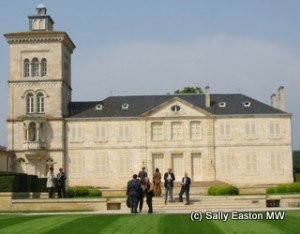Bordeaux and climate change: reds.
Four top Bordeaux producers recently got together in London to discuss climate change and the Bordeaux paradigm over the past 20 years.
Present were:
- Jean-Christophe Mau, owner of Château Brown in Pessac-Léognan.
- Bruno Eynard, general manager of third growth Chateau Lagrange in Saint-Julien.
- Eric Perrin, owner of Chateau Carbonnieux in Pessac-Léognan, classified for red and white.
- Francois Despagne, owner of Chateau Grand-Corbin-Despagne in Saint Emilion, promoted to St. Emilion Grand Cru Classé in 2006.
Red wine
(Whites here.) The discussion naturally and immediately gravitated to reds, which account for 90% of Bordeaux production. The ability to grow and create a unique balance is one of claret’s enduring qualities, but how and when will a warming climate begin to degrade that balance? Eynard said “it’s the balance between alcohol and acidity that’s unique in the world, with 3.2 to 3.4 [g/l total acid expressed as sulphuric; (5 to 5.2 g/l expressed as tartaric)] acid, and rich in tannins. It’s impossible to find this elsewhere in the world. But I feel this balance is threatened by climate change, and the 2003 vintage is the evidence.”

Château Lagrange
Part of the arguably changing style of Bordeaux red wine seems to conflict with a warming climate, where picking times would generally become earlier in order to retain freshness. In Bordeaux, which is essentially a cooler, marginal climate for the grape varieties grown there, greater knowledge, especially understanding the difference between physiological and phenolic ripeness, which develop along different curves, has lead to later picking. Eynard said “today we pick one week later than before because we’re able to check the ripeness of polyphenols. Twenty years ago, we would have picked the 2009 earlier than we did. And because we wait for a good ripeness of the seed tannins, the alcohol also goes up, but it’s better for the overall balance of the wine.”
Over on the right bank, the warming climate issues are slightly modified by the soils. Despagne said “Pomerol and northern St. Emilion have more gravel and sand. Here the harvest is earlier that where the soil is clay-limestone. There are more problems on clay-limestone due to the concentration, with some alcohols reaching 14%, 14.5%, even 15%.”
Vintage 2003 was a seminal moment also for Despagne. He said: there is a problem when physiological and phenolic ripeness do not occur at the same moment. In 2003 physiological ripeness came, and we waited for phenolic ripeness. Then we got the concentration, with small berries and lower acidity.”
In the great 2005, as well as 2009, predicted for greatness, Despagne said these different aspects of ripeness proceeded at a similar pace, resulting in high concentration, yet with a good level of acidity. Synchronised ripening of sugars and phenols is the ideal scenario.
Vintage 2003 was more of a new world vintage, and, said Despagne, “it was a good vintage to change.” It’s surprising to imagine the Bordelais as inexperienced, but, said Eynard “hot vintages are the most difficult to manage. We don’t know them very well. No-one find the right dates for picking, one neighbour picks two weeks ahead of the other neighbour. It’s the same for vinification: we are less experienced.”
This was the vintage that stopped these guys dealing systematically with their vineyard management. Where once they would have routinely de-leafed in June and July, Despagne de-leafed just one side in 2003, and only once, and “in 2005, with the water stress of that year, we limited de-leafing” leaving more bunches in the lower evapo-transpiration zone of shade. “Now” he said “we don’t work systematically. We adapt our canopy management according to the weather.”
Part of Despagne’s adaptation is to increase his cabernet franc plantings. He said “I am increasing cabernet franc because of the balance [in the wine]. It has tannins and acidity and doesn’t have big alcohol. Cabernet franc to help deal with climate change is very interesting.”
Data on average alcohol levels from the CIVB show remarkably little increase in figures. In the 17 years from 1990 to 2007, St Estephe has moved from an average 12.9% to 12.6%, peaking at 13.2% in 2002. Pomerol has moved from 12.8% to 13.1% in the same period. St. Emilion is 13.1% in both 1990 and 2007, though got up to 14% for the 2005 vintage. However this is all rather spurious as it is muddied by the chaptalisation waters.

Jean-Christophe Mau, of Ch. Brown
At the four Châteaux, between these dates, yields have not fluctuated markedly, nor have total acidity figures, or pH, which runs between 3.6 and 3.8. Alcohol extremes are 12.5% (Château Brown, 2000) and 13.9%, also Château Brown, 2009).
Despagne reverted to the balance of Bordeaux wines, saying “we must understand what happens, and do what is necessary. In 2005, and 2009, the alcohol is important [high], and the tannins are rich, with balance. Also the pH is more interesting, 3.6, 3.7” which keeps that fresh balance alongside the richness and concentration. Mau added: “in 2005 the sugar level of cabernet sauvignon at Château Brown was 12.5%. In 2009, it was 14%, but my acidity is good” reflecting the more synchronised ripening of sugar and phenols in that vintage.
The longer cycle
Looking beyond the last 20 years, a short series of hotter or colder years can be identified in most decades: the 1940s, the 2000s on the hotter side; the 1960s, the 1990s on the cooler side. The vintage of easy choice to pluck out of the pantheon on such occasions is the remarkable 1947 vintage, with Cheval Blanc being cited with alcohol of 14.4%.
But Eynard has noted a changing theme to the decade rule of thumb. He said: “in a decade we used to get one exceptional, three good, three medium and three modest [for which read not great]. Now we get 3 exceptional, six very good and one medium.” Despagne emphasised the point “we have no more bad vintages in Bordeaux.” Which for the immediate moment, is enviable.
However, no-one is in any doubt that the climate is warming. For the moment, the Bordelais have some time to adapt each year. Being originally ‘cooler climate’, in fact a warming climate in the short term enable grapes to ripen more regularly and consistently, as Eynard noted, saying “it’s not too late for us. The new weather is still comfortable for us. We have enough technical capabilities to manage the vineyard, for example de-leafing, the date of the harvest, even a higher crop could be possible.” But he warned, “the most difficult choices are for the next 20, 30, 40 years. For example, when we plant, should we drain, because in 20 years we will need the water.”
Whether the choice of grape varieties planted might change is also an issue to address now. Despagne is already planting more cabernet franc.
Anecdotal tasting
We tasted 2007s, 2003s and 1989s from the châteaux, being one cool and two hot vintages. Whilst trying to eliminate the variation of age … and hopefully not pre-empting what one might be expecting to taste … the 2007s were unexpectedly fine and approachable, obviously youthful with tight, sweet fruit in the ‘cooler’ blackcurrant spectrum.
On the 2003s, by comparison, I felt the tannins, rather than alcohol gave away the heat of the 2003 vintage. Indeed the alcohol was supremely well integrated across the board: ‘warmth of alcohol’ didn’t feature in any of my notes. The 2003 tannins though, relatively, I felt to be a little coarser, a little chunkier, a little grittier, a little more granular, and hessian-textured, with a little more friction in the mouth, by comparison to the smooth, almost slippery and fine-grained tannins in 2007. I supposed the heat of 2003 was challenging for the phenolic development.
On this purely anecdotal tasting, bottle evolution may also become an issue in a warming climate. I felt the 1989s to be approaching full maturity, indeed one of wines I felt to be drying out just a little. Perhaps the – relatively speaking – coarser-textured tannins of the 2003 are also more evolved than in a cooler vintage and may be less able to provide traditional levels of bottle ageing capacity.
All were still medium-bodied, so classically Bordeaux, with no overtly noticeable alcoholic perception, so no risk yet of Bordeaux becoming a chunky, clunky, full-bodied, alcoholic, spicy and jammy wine, which one might be forgiven for associating Bordeaux grape varieties in a hot climate.
Comments
One Response to “Bordeaux and climate change: reds.”




April 7, 2010 at 2:49 am
I agree that the climate of Bordeaux is changing. How much has it changed over the past 40 years is difficult to know. Check out:
http://albemarleterroir.com/2009/06/wine-qaulity-and-bordeaux-climate-impact-of-a-weather-station-move